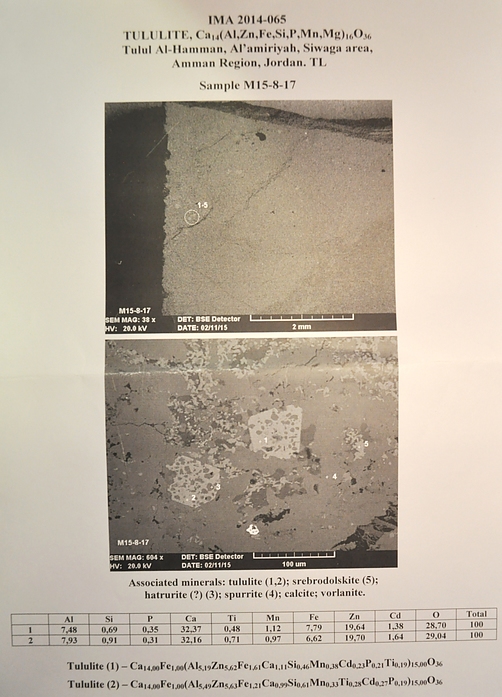Tululite
A valid IMA mineral species
This page is currently not sponsored. Click here to sponsor this page.
About Tululite
Formula:
Ca14(Fe3+,Al)(Al,Zn,Fe3+,Si,P,Mn,Mg)15O36
Colour:
Yellow with greenish tint
Lustre:
Vitreous
Hardness:
6½
Specific Gravity:
3.826 (Calculated)
Crystal System:
Isometric
Name:
The name was chosen after the geographical name Tulul Al Hammam (Arabic for Pigeon Hills) located in the northern Siwaqa area, where the mineral was found.
Tululite belongs to a group of compounds with the general formula Ca14MT15O35+x (0 ≤ x ≤ 1), and is a new structure type.
Unique Identifiers
Mindat ID:
46500
Long-form identifier:
mindat:1:1:46500:9
GUID
(UUID V4):
(UUID V4):
7b0de3ce-3255-4dba-8c6f-9a4f54aeb1a4
IMA Classification of Tululite
Approved
Approval year:
2014
First published:
2016
Classification of Tululite
4.BC.30
4 : OXIDES (Hydroxides, V[5,6] vanadates, arsenites, antimonites, bismuthites, sulfites, selenites, tellurites, iodates)
B : Metal: Oxygen = 3:4 and similar
C : With medium-sized and large cations
4 : OXIDES (Hydroxides, V[5,6] vanadates, arsenites, antimonites, bismuthites, sulfites, selenites, tellurites, iodates)
B : Metal: Oxygen = 3:4 and similar
C : With medium-sized and large cations
Mineral Symbols
As of 2021 there are now IMA–CNMNC approved mineral symbols (abbreviations) for each mineral species, useful for tables and diagrams.
| Symbol | Source | Reference |
|---|---|---|
| Tlu | IMA–CNMNC | Warr, L.N. (2021). IMA–CNMNC approved mineral symbols. Mineralogical Magazine, 85(3), 291-320. doi:10.1180/mgm.2021.43 |
Physical Properties of Tululite
Vitreous
Transparency:
Transparent
Colour:
Yellow with greenish tint
Streak:
White
Hardness:
6½ on Mohs scale
Hardness:
VHN50=729(10) kg/mm2 - Vickers
Tenacity:
Brittle
Cleavage:
None Observed
Parting:
None observed
Fracture:
Irregular/Uneven
Density:
3.826 g/cm3 (Calculated)
Optical Data of Tululite
Type:
Isotropic
RI values:
n = 1.746(2)
Birefringence:
Isotropic minerals have no birefringence
Surface Relief:
High
Chemistry of Tululite
Mindat Formula:
Ca14(Fe3+,Al)(Al,Zn,Fe3+,Si,P,Mn,Mg)15O36
Crystallography of Tululite
Crystal System:
Isometric
Class (H-M):
2 3 - Tetartoidal
Space Group:
F2 3
Cell Parameters:
a = 14.9346(4) Å
Unit Cell V:
3331.07 ų
Z:
4
Morphology:
Irregular grains
X-Ray Powder Diffraction
Powder Diffraction Data:
| d-spacing | Intensity |
|---|---|
| 2.874 Å | (44) |
| 2.874 Å | (33) |
| 2.640 Å | (100) |
| 2.524 Å | (31) |
| 2.524 Å | (23) |
| 2.278 Å | (30) |
| 1.760 Å | (16) |
| 1.524 Å | (25) |
Comments:
From Type Description.
Geological Environment
Paragenetic Mode(s):
| Paragenetic Mode | Earliest Age (Ga) |
|---|---|
| Stage 10a: Neoproterozoic oxygenation/terrestrial biosphere | <0.6 |
| 51 : Pyrometamorphic minerals (see also #54 and #56) | <0.36 |
Type Occurrence of Tululite
General Appearance of Type Material:
In thin clusters as irregular grains with indented outlines (20–100 μm in size), having typical open-work textures
Place of Conservation of Type Material:
Type materialis deposited in the collections of the Central Siberian Geological Museum of the V.S. Sobolev Institute of Geology and Mineralogy, 3 Ac. Koptyuga Avenue, Novosibirsk 630090, Russia, catalogue number VII-91/1
Geological Setting of Type Material:
In medium-temperature (800–850 °C) combustion metamorphic (CM) spurrite-fluorellestadite marbles
Associated Minerals at Type Locality:
Reference:
Khoury, H.N., Sokol, E.V., Kokh, S.N., Seryotkin, Y.V., Nigmatulina, E.N., Goryainov, S.V., Belogub, E.V., Clark, I.D. (2016): Tululite, Ca14(Fe3+,Al)(Al,Zn,Fe3+,Si,P,Mn,Mg)15O36: a new Ca zincate-aluminate from combustion metamorphic marbles, central Jordan. Mineralogy and Petrology: 110: 125-140.
Synonyms of Tululite
Common Associates
Associated Minerals Based on Photo Data:
| 1 photo of Tululite associated with Srebrodolskite | Ca2Fe3+2O5 |
| 1 photo of Tululite associated with Spurrite | Ca5(SiO4)2(CO3) |
Related Minerals - Strunz-mindat Grouping
| 4.BC. | Addibischoffite | Ca2Al6Al6O20 |
| 4.BC. | Ellinaite | CaCr2O4 |
| 4.BC. | Igelströmite | Fe3+(SbPb)O4 |
| 4.BC.05 | Marokite | CaMn3+2O4 |
| 4.BC.10 | Dmitryivanovite | CaAl2O4 |
| 4.BC.15 | Warkite | Ca2Sc6Al6O20 |
| 4.BC.25 | Kudryavtsevaite | Na3(Mg,Fe)(Fe,Ti)2Ti3O12 |
| 4.BC.30 | Valleyite | Ca4Fe6O13 |
| 4.BC.35 | Krotite | CaAl2O4 |
Fluorescence of Tululite
Non--fluorescent under ultraviolet light
Other Information
Notes:
Dissolves in 1.5 % HCl
Health Risks:
No information on health risks for this material has been entered into the database. You should always treat mineral specimens with care.
Internet Links for Tululite
mindat.org URL:
https://www.mindat.org/min-46500.html
Please feel free to link to this page.
Please feel free to link to this page.
Search Engines:
External Links:
Mineral Dealers:
References for Tululite
Localities for Tululite
Locality List
 - This locality has map coordinates listed.
- This locality has map coordinates listed.
 - This locality has estimated coordinates.
ⓘ - Click for references and further information on this occurrence.
? - Indicates mineral may be doubtful at this locality.
- This locality has estimated coordinates.
ⓘ - Click for references and further information on this occurrence.
? - Indicates mineral may be doubtful at this locality.
 - Good crystals or important locality for species.
- Good crystals or important locality for species.
 - World class for species or very significant.
(TL) - Type Locality for a valid mineral species.
(FRL) - First Recorded Locality for everything else (eg varieties).
- World class for species or very significant.
(TL) - Type Locality for a valid mineral species.
(FRL) - First Recorded Locality for everything else (eg varieties).
All localities listed without proper references should be considered as questionable.
Jordan (TL) | |
| Williams et al. (2015) +2 other references |
| Sokol +10 other references |
Quick NavTopAbout TululiteUnique IdentifiersIMA Classification Classification Mineral SymbolsPhysical Properties Optical Data Chemistry Crystallography X-Ray Powder DiffractionGeological EnvironmentType Occurrence SynonymsCommon AssociatesStrunz-MindatFluorescence Other InformationInternet Links References Localities Locality List


 symbol to view information about a locality.
The
symbol to view information about a locality.
The 



Tulul al Hammam, Siwaga, Lisdan-Siwaga Fault, Hashem region, Daba-Siwaqa complex, Transjordan Plateau, Amman Governorate, Jordan